Management Accounting: Approaches, Reporting Methods, and Integration with Organizational Processes
23 Pages4132 Words41 Views
Added on 2023-01-12
About This Document
This study explores the different approaches and reporting methods in management accounting, as well as how they integrate with organizational processes. It discusses the benefits of management accounting systems and provides examples of cost cards and their preparation using absorption costing and marginal costing. The study also highlights the potential merits and demerits of absorption costing and marginal costing.
Management Accounting: Approaches, Reporting Methods, and Integration with Organizational Processes
Added on 2023-01-12
ShareRelated Documents
MANAGEMENT
ACCOUNTING
ACCOUNTING
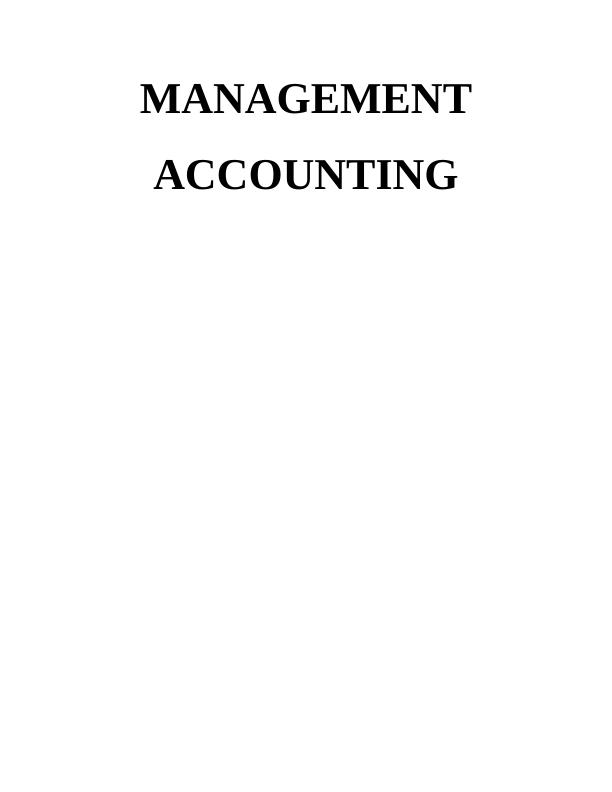
Contents
Contents...........................................................................................................................................2
INTRODUCTION...........................................................................................................................3
MAIN BODY..................................................................................................................................3
SECTION 1.....................................................................................................................................3
1.1................................................................................................................................................3
2.2................................................................................................................................................5
1.3................................................................................................................................................5
1.4................................................................................................................................................6
2.1................................................................................................................................................7
(a).................................................................................................................................................7
(b).................................................................................................................................................9
2.2..............................................................................................................................................10
2.3..............................................................................................................................................11
(a)...............................................................................................................................................12
(b.)..............................................................................................................................................13
SECTION 2...................................................................................................................................14
3.1..............................................................................................................................................14
4.1..............................................................................................................................................18
4.2..............................................................................................................................................20
4.3..............................................................................................................................................21
CONCLUSION..............................................................................................................................22
REFERENCES..............................................................................................................................23
Contents...........................................................................................................................................2
INTRODUCTION...........................................................................................................................3
MAIN BODY..................................................................................................................................3
SECTION 1.....................................................................................................................................3
1.1................................................................................................................................................3
2.2................................................................................................................................................5
1.3................................................................................................................................................5
1.4................................................................................................................................................6
2.1................................................................................................................................................7
(a).................................................................................................................................................7
(b).................................................................................................................................................9
2.2..............................................................................................................................................10
2.3..............................................................................................................................................11
(a)...............................................................................................................................................12
(b.)..............................................................................................................................................13
SECTION 2...................................................................................................................................14
3.1..............................................................................................................................................14
4.1..............................................................................................................................................18
4.2..............................................................................................................................................20
4.3..............................................................................................................................................21
CONCLUSION..............................................................................................................................22
REFERENCES..............................................................................................................................23
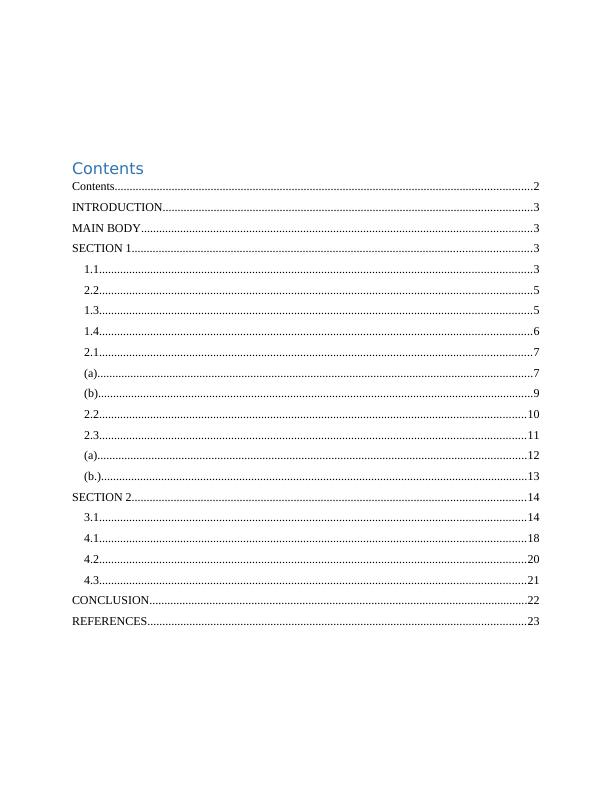
INTRODUCTION
There are multiple accounting approaches in finance field that are used by organisations
and one of them is managerial accounting. It can be comprehended as a sort of accounting and
reporting in which accounting personnel evaluate fiscal and budgetary information for internal
management decision making. This is systematically designed framework which generally used
by corporations and business entities to collect key information and data to facilitate effective
managerial decision-making. This comprehensive approach which involve key techniques and
system to assist managing staff in managerial and financial task (Christ., 2014).
This study contains explanations about different aspects associated with management
accounting along with practical sum in context of UCK Furniture. This also discuss about some
core reporting methods of MA which help personnel within organisation to report major
information to top management.
MAIN BODY
SECTION 1
1.1.
Management Accounting: This is defined as a sort of accounting and managerial framework
method which generates quantitative and fiscal information for developing a base for managers
with aim to assist them in decision making. That leads to successful organization management.
Managers utilize accounting information by managers to select a method for communicating it,
and to decide how effectively to execute it (Bennett and James, 2017). They employ accounting
information from managers to organize their choices about design, development and promotion
of a good or service. This also consists of some systems which are employed and adapted by
managing personnel to generate information and ensure availability of meaningful information
which are lastly used by them in taking efficient and effective decisions.
Management accounting systems are utilized to track costs attributable to the different
products and services being produced. s There are distinct forms of MA systems which
are below:
Price optimisation system: This system displays the connection between supply as well
as demands and is how pricing influences every item's demands and then integrates all
related data with stock levels and rates to determine the correct prices which can help
There are multiple accounting approaches in finance field that are used by organisations
and one of them is managerial accounting. It can be comprehended as a sort of accounting and
reporting in which accounting personnel evaluate fiscal and budgetary information for internal
management decision making. This is systematically designed framework which generally used
by corporations and business entities to collect key information and data to facilitate effective
managerial decision-making. This comprehensive approach which involve key techniques and
system to assist managing staff in managerial and financial task (Christ., 2014).
This study contains explanations about different aspects associated with management
accounting along with practical sum in context of UCK Furniture. This also discuss about some
core reporting methods of MA which help personnel within organisation to report major
information to top management.
MAIN BODY
SECTION 1
1.1.
Management Accounting: This is defined as a sort of accounting and managerial framework
method which generates quantitative and fiscal information for developing a base for managers
with aim to assist them in decision making. That leads to successful organization management.
Managers utilize accounting information by managers to select a method for communicating it,
and to decide how effectively to execute it (Bennett and James, 2017). They employ accounting
information from managers to organize their choices about design, development and promotion
of a good or service. This also consists of some systems which are employed and adapted by
managing personnel to generate information and ensure availability of meaningful information
which are lastly used by them in taking efficient and effective decisions.
Management accounting systems are utilized to track costs attributable to the different
products and services being produced. s There are distinct forms of MA systems which
are below:
Price optimisation system: This system displays the connection between supply as well
as demands and is how pricing influences every item's demands and then integrates all
related data with stock levels and rates to determine the correct prices which can help
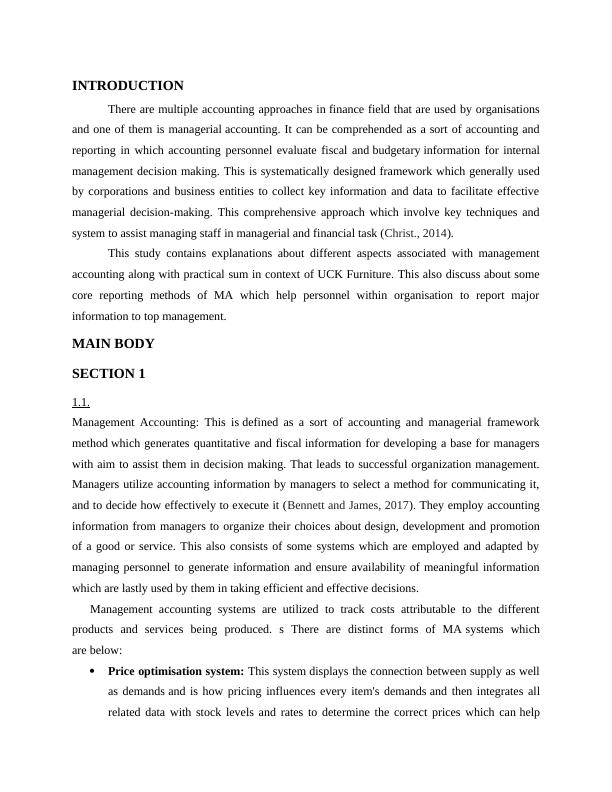
company to boost its income levels. This may also be utilized to check the consumers
'reaction to the actual pricing increases that arise if the commodity quality increases then
how the buyers will respond to it as well as that markets will be drawn in order to allow
potential choices on which demand to adjust in order to gain full profitability. This
system requires detailed analysis of cost, price and demand aspects and evaluation of
relation or trend between them.
Inventory management system: This is a system where orders are managed, processed,
and then used to manufacture the products. This also controls the rate of saleable items. It
will assist with making correct quantity inventory decisions as well as with respect to
storage centres. This system is consistent with the cycle of maintaining control of all
products bought and shipped out by businesses over a given period/time frame (Hall, M.,
2016). In this, inventory valuation is performed in conjunction with specific techniques,
like the LIFO approach, the FIFO approach and weighted average costs methodology. All
of these strategies play a substantial role for corporations in monitoring precise amounts
of materials at the moment it is required. This system requires use of specific method or
technique for valuing stock, assumption used and information about process adopted by
entity regarding inventories.
Job costing system: This is a method or system, in which all
crucial knowledge/information are to be collected in regard to the expense connected
with the manufacture of the particular commodity that is chargers. It can be tested with
the aid of corporations estimating framework. Accumulating direct content, labour, and
overhead costs in this information. The firm can quote rates that would help business gain
sustainable profits. Perquisites of this system involve detailed cost sheet which describes
cost related to each job and basis for identification of specific process as job and
allocation of costs to such job.
Cost accounting systems: This is a method used by a company in which manufacturing
operations are to be documented using continuous inventory systems. There are
essentially five components of this device that are an input estimation base, an inventory
valuation process in which product calculation is made, then for aggregation of all cost
structure, the fourth is output flow inference, and the last is capacity at some stages of
'reaction to the actual pricing increases that arise if the commodity quality increases then
how the buyers will respond to it as well as that markets will be drawn in order to allow
potential choices on which demand to adjust in order to gain full profitability. This
system requires detailed analysis of cost, price and demand aspects and evaluation of
relation or trend between them.
Inventory management system: This is a system where orders are managed, processed,
and then used to manufacture the products. This also controls the rate of saleable items. It
will assist with making correct quantity inventory decisions as well as with respect to
storage centres. This system is consistent with the cycle of maintaining control of all
products bought and shipped out by businesses over a given period/time frame (Hall, M.,
2016). In this, inventory valuation is performed in conjunction with specific techniques,
like the LIFO approach, the FIFO approach and weighted average costs methodology. All
of these strategies play a substantial role for corporations in monitoring precise amounts
of materials at the moment it is required. This system requires use of specific method or
technique for valuing stock, assumption used and information about process adopted by
entity regarding inventories.
Job costing system: This is a method or system, in which all
crucial knowledge/information are to be collected in regard to the expense connected
with the manufacture of the particular commodity that is chargers. It can be tested with
the aid of corporations estimating framework. Accumulating direct content, labour, and
overhead costs in this information. The firm can quote rates that would help business gain
sustainable profits. Perquisites of this system involve detailed cost sheet which describes
cost related to each job and basis for identification of specific process as job and
allocation of costs to such job.
Cost accounting systems: This is a method used by a company in which manufacturing
operations are to be documented using continuous inventory systems. There are
essentially five components of this device that are an input estimation base, an inventory
valuation process in which product calculation is made, then for aggregation of all cost
structure, the fourth is output flow inference, and the last is capacity at some stages of
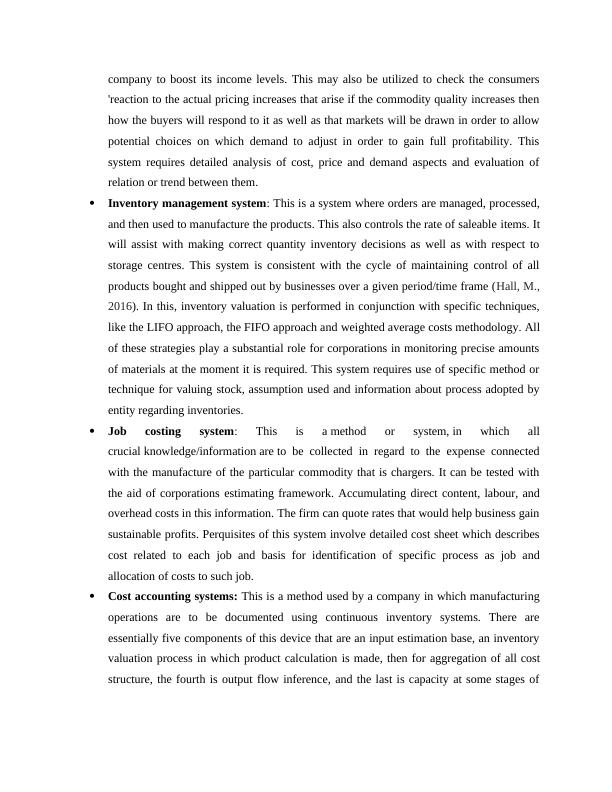
product cost flow reporting. Knowledge provided by this program in the allocation
decision-making process and also in productivity review of the various agencies.
2.2.
Various method of MA reporting:
MA reports can be interpreted systematically as those reported reports consisting of
information on financial and organisational parts. Such reported data is commonly utilized by
business organizations 'management team in order to carry effective measures at the right time.
Cost reporting- This report is being produced by incorporation of the framework of cost
accounting. This kind of report provides detail on costs that result in the execution of critical
business and management tasks. Activities are classified according to their amount of
expenditures together with such report. The intention of this report is to concentrate on certain
components and factors that absorb higher cost quantities (Jacobs, 2012).
Stock report- This could be described as a form of report providing details on priced volume of
material contained in warehouses. The sole purpose of this sort of report is to assist the
production division in taking the appropriate measures on how many units are needed to be
produced. Within the background of the aforementioned business, their production department
produces drinks by absorbing essential information via this report in cost-effective manner.
Accounts receivable report- This report sets up in a reasonable manner details about amount of
debtors who are liable for business enterprises with settlement date. The purpose of drafting this
report is to assist the division of finance in keeping the reforms and policies effective. Their
finance team uses crucial details helps to create strategies to raise debts from different debtors.
1.3.
Benefits of management accounting systems:
Name of MAS Benefit
Price optimisation system This is helpful for undertakings to fix product prices in accordance
with the latest industry pattern. This system enables managers to
set a most efficient price at which company can enjoy maximum
profit at optimum cost.
Inventory management
system
The value of retained stock under this accounting system is
measured in an appropriate way. the main benefit of this
decision-making process and also in productivity review of the various agencies.
2.2.
Various method of MA reporting:
MA reports can be interpreted systematically as those reported reports consisting of
information on financial and organisational parts. Such reported data is commonly utilized by
business organizations 'management team in order to carry effective measures at the right time.
Cost reporting- This report is being produced by incorporation of the framework of cost
accounting. This kind of report provides detail on costs that result in the execution of critical
business and management tasks. Activities are classified according to their amount of
expenditures together with such report. The intention of this report is to concentrate on certain
components and factors that absorb higher cost quantities (Jacobs, 2012).
Stock report- This could be described as a form of report providing details on priced volume of
material contained in warehouses. The sole purpose of this sort of report is to assist the
production division in taking the appropriate measures on how many units are needed to be
produced. Within the background of the aforementioned business, their production department
produces drinks by absorbing essential information via this report in cost-effective manner.
Accounts receivable report- This report sets up in a reasonable manner details about amount of
debtors who are liable for business enterprises with settlement date. The purpose of drafting this
report is to assist the division of finance in keeping the reforms and policies effective. Their
finance team uses crucial details helps to create strategies to raise debts from different debtors.
1.3.
Benefits of management accounting systems:
Name of MAS Benefit
Price optimisation system This is helpful for undertakings to fix product prices in accordance
with the latest industry pattern. This system enables managers to
set a most efficient price at which company can enjoy maximum
profit at optimum cost.
Inventory management
system
The value of retained stock under this accounting system is
measured in an appropriate way. the main benefit of this
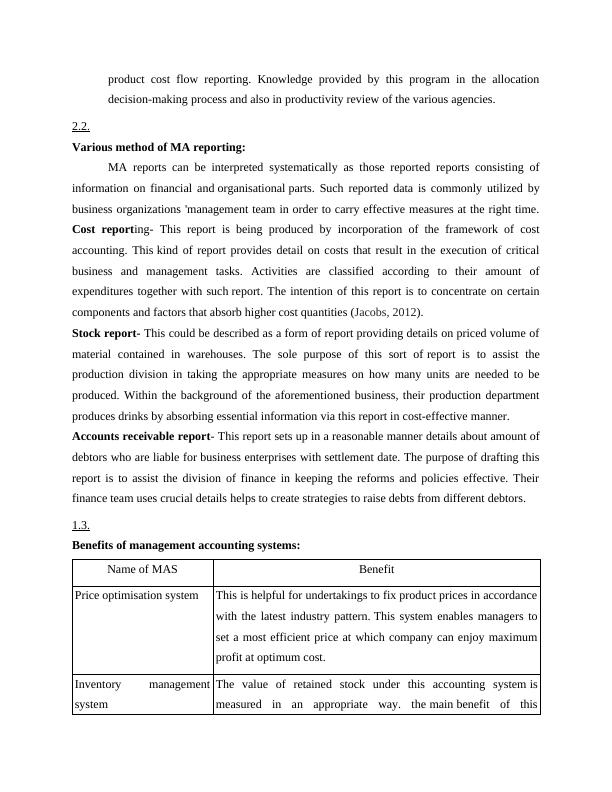
accounting system is optimizing aggregate inventory costs.
Job costing system It is helpful for business organizations to effectively allocate costs
to each specified job-process. This offer effective accountability
within organisational processes as due to this system it is easy to
allocate any cost creating process.
Cost accounting system By measuring correct degree of variances, it is combined with the
dimension of managing total costs of specific
operations. Company can employ this accounting system to
control the actual manufacturing costs and handle certain tasks
whose expense is beyond forecast.
1.4.
Integration of MAS and MA reports with organisational process.
Management accounting systems/frameworks & management accounting reports are typically
incorporated into the company's operations, because reports would include the necessary details
on the grounds of which appropriate documentation will be performed and related information
can be collected by management accounting systems. Because separate management accounting
systems supply information on multiple factors that are needed in the reporting process, it can
support reporting by offering advice and steps to address any problems that occur in the
organization in separate divisions and thus incorporating them for advantage of the organization
(Lavia López and Hiebl, 2014).
Job costing system It is helpful for business organizations to effectively allocate costs
to each specified job-process. This offer effective accountability
within organisational processes as due to this system it is easy to
allocate any cost creating process.
Cost accounting system By measuring correct degree of variances, it is combined with the
dimension of managing total costs of specific
operations. Company can employ this accounting system to
control the actual manufacturing costs and handle certain tasks
whose expense is beyond forecast.
1.4.
Integration of MAS and MA reports with organisational process.
Management accounting systems/frameworks & management accounting reports are typically
incorporated into the company's operations, because reports would include the necessary details
on the grounds of which appropriate documentation will be performed and related information
can be collected by management accounting systems. Because separate management accounting
systems supply information on multiple factors that are needed in the reporting process, it can
support reporting by offering advice and steps to address any problems that occur in the
organization in separate divisions and thus incorporating them for advantage of the organization
(Lavia López and Hiebl, 2014).

End of preview
Want to access all the pages? Upload your documents or become a member.
Related Documents
Management Accounting Systems and Reportinglg...
|24
|2779
|62
Management Accounting and Costing Methodslg...
|20
|2473
|92
Management Accounting: Systems, Reporting, and Integrationlg...
|29
|4421
|90
Management Accounting Systems and Budget Preparationlg...
|24
|2763
|93
Management Accounting: Difference, System, Reporting Methodslg...
|16
|935
|96
Management Accounting: Types of Financial Accountancy, Reporting Systems, and Accounting Methodologieslg...
|16
|3686
|322
